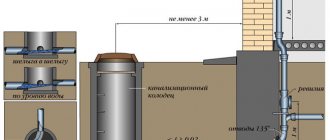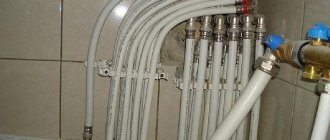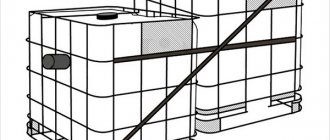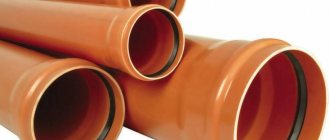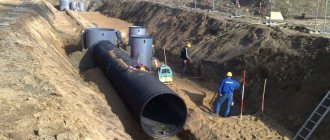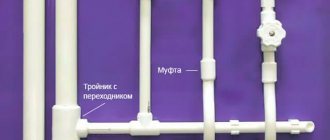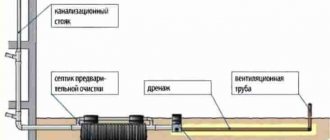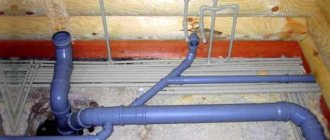Any owner of a plot of land before constructing a residential building solves the primary task - creating an autonomous well. This issue is relevant for people who do not have the opportunity to connect to the central highway. Unfortunately, in Russia there are many small settlements that do not use the services of water utilities. This is due to the huge economic costs due to the large distance from megacities to small settlements. And since drinking liquid is a strategic resource, without which life would end, we will tell you how to properly organize, make, assemble and install a water supply system in a house, on a countryside dacha with your own hands, what is needed for this - about the scheme of water supply for dachas.
Features of an individual source
Independence from the state is an expensive luxury, since you have to bear all the costs of installation, maintenance and repair of the entire complex. However, autonomy in the future will allow you not to pay for the incoming liquid. Thus, you can use an unlimited volume for household needs, cooking, filling the pool and shower, watering the front garden and vegetable garden.
The simplest option, when a well was built next to the house and a pump was placed in it with an attached hose, the end of which remained in a free position, has become obsolete. Modern realities have shown that citizens want to live in comfortable conditions not only in summer, but also in winter. Innovative technologies make it possible to build a house with all communications.
Before starting a business, the owner plans everything: from planting trees, placing a building, garage, sheds to arranging and installing a water supply system in the dacha.
The sketch includes:
- Creation of a separate room to accommodate the entry point, boiler unit (storage), heater and other technical devices. For this, a room on the ground floor with an area of up to 4 square meters is quite sufficient.
- A certain amount of materials and components (polypropylene or metal pipes, fittings, connectors).
- Distribution diagrams of all main elements of the complex.
- Step-by-step installation plan.
- Estimate.
The rather voluminous design consists of the following parts:
- A pump for lifting liquid to the surface.
- Pressure gauge for accurate pressure measurement.
- Expansion tank to maintain the required pressure level.
- A relay designed to stabilize the current in an electrical circuit.
- Full automatic protection.
- Filters for coarse and fine cleaning, preventing the ingress of various impurities. The functionality of the devices depends on the model. Some types get rid of abrasive particles of sand, clay, silt, and fine gravel. Others perform deeper filtration, including iron removal and aeration.
- Storage or instantaneous water heater. The choice depends on the financial capabilities and preferences of the client.
- The package often includes pipes of different diameters, fittings and taps.
Casing
It is better to use steel casing pipes for wells, especially deep ones, as they are not only more reliable than others, but are also easier to connect. The casing pipe consists of individual links. Their length is 2-4 m. Threaded couplings or welding are used to connect steel links.
Which method of connecting the links to choose depends on the diameter of the pipe. Thus, it is easier to connect pipes with an internal diameter of 50 mm with couplings, and pipes with a diameter of 100 mm or more - by welding.
To connect casing pipe links using welding, it is necessary to cut the pipe into individual links (2^3 m long) with an oxygen cutter. The cutting line should be made with a toe. This is necessary in order to facilitate centering during welding, and also to ensure that the joint does not have large gaps. Each cut must be marked with paint.
Centering of the links before welding is carried out using a jig made of two corners or three steel plates, which should be welded to the rods. This will give strength to the connecting seam.
If there is no welding or a non-steel casing pipe is used, the links can be connected with bolted steel plates. The width of the overlays is 15-30 mm, the length is 100-200 mm, the thickness is 6-9 mm. Narrow edges of the overlays should be cut at an angle of 30°. This is necessary so that the tool does not cling to the internal gaskets, and the external gaskets prevent the pipe from passing through the ground.
On the internal linings for fastening, pe-\u003e-£4hi is cut, but the connection of a steel or cast iron casing pipe can be made without internal linings. To do this, you need to cut a thread directly in the wall.
Choosing a source for creating a water supply system in a country house
During the planning process, all possible options should be explored. The behavior of geodetic reconnaissance, which examines soil parameters, the depth of ground or surface water, and the mineral composition of the proposed liquid, is considered important. Based on the results obtained, you can decide on the most optimal model for you.
Well
Construction of a private mine is recommended if the aquifer is at least ten meters deep. In addition, to avoid the entry and proliferation of organic matter, the structure must be hermetically sealed.
Today, two construction options are used:
- The shaft well is equipped with cylindrical concrete rings with diameters that allow manual cleaning of the bottom. The advantage is increased productivity due to the large influx. The downside is the high cost of materials and labor.
- Tubular. For this model, asbestos pipes are used. In addition, they are quite suitable for a narrow puncture from a building, this provides a guaranteed volume to meet the household needs of a family of 3-5 people.
How to lay, equip and connect a water supply system in a dacha from the central main
Before starting work, you must obtain permission from the water utility of the area to which you are connected. The organization’s specialists will consider your question in the shortest possible time and give a positive or negative answer. It will depend on whether it is possible to lay pipes to your site. There may be insurmountable obstacles in the form of strategic objects, railways and highways, rocks, etc. In addition, if there is a long distance, then part of the costs will have to be borne by yourself, and these are significant costs.
To initiate the process, you need to collect a large number of documents, buy a meter, and pay for the work. The connection operation will not take much time. You will need to dig a trench of a certain length, pour a 15-20 cm layer of sand into it, lay a line of pipes, insulate it and tie it into the main line.
How to bring water to a country house on a plot of land with your own hands from a living source
The option is, of course, interesting, but it requires a lot of money. The main problem is the presence of a lake, pond, river or stream within a short distance. For drinking needs, you will need to install a multi-stage filter station, since without it you will end up with a low-quality liquid that can cause serious harm to your health. To water, you just have to lay a pipeline, place a pump in the source and connect to the power supply.
water well
This drilling process is very expensive and requires surveying and careful attention from the work crew. However, having received such access, you will be guaranteed to be provided with high-quality water for an indefinite period in any volume. The only negative is that constant monitoring of the equipment is required for preventive inspection and repair work.
Stainless steel and copper
A serious problem with metal can be the appearance of corrosion on the surface during prolonged use without waterproofing. That is why they began to produce versions made of copper and stainless steel. They are reliable and durable, and can be used for supplying cold and warm water, as well as draining wastewater. They are often chosen by people who do not want to save money on water supply or drainage work.
Despite a fairly large number of advantages, the pipes in question are used extremely rarely today. This is due to the following points:
- There is a high probability of deposits and plaque appearing on the walls.
- When carrying out installation work, welding work is required.
- High cost, especially copper options.
- Heavy weight, which makes it difficult to carry out delivery and installation work.
- High requirements for insulation to eliminate the possibility of water crystallization when the soil freezes, which leads to a breakthrough of the system due to expansion of the liquid.
For a summer cottage, it is recommended to use such pipes only with careful insulation of the main line. The cost of insulation, the complexity of the work carried out, the cost of the materials used determine that a system of stainless and copper pipes is a very expensive investment.
Winter or summer water supply system for a country house
Depending on the preferences of the owner and his plans for using the cottage, one of two options for connecting to the central highway is selected: the structure will function exclusively in warm weather or all year round.
MBFT-75 Membrane for 75GPD
SF-mix Clack up to 0.8 m3/h
SF-mix Runxin up to 0.8 m3/h
Both models are semi-autonomous and include a mandatory connection to the power grid and the pipeline entry point. In addition, they must be equipped with a suspension and preservation system to prevent freezing and premature failure of the pipes themselves, whether metal or plastic. The drainage of moisture occurs at the end of the summer season, and in the winter - after each departure to the city.
What does a typical water supply system look like in a country house?
Depending on the model and manufacturer, the product is equipped with the following elements:
- A welded or paired pipe line made of polypropylene, iron or metal-plastic.
- Fittings, fittings, hoses.
- Relay to maintain normal voltage in an electrical circuit.
- Manometer for measuring pressure.
- Pump equipment.
- Storage tank of different volumes.
- Heater.
- Filters.
- Automatic devices.
How to choose a pump
Before purchasing a product, you must consult with competent specialists.
Professionals will definitely select an option for you based on the following parameters:
- Height of the water column.
- The volumes necessary to meet all the needs of the family.
- Issued displacement per unit of time without a critical drop in level.
- The diameter of the rings laid in the ground.
- Liquid pressure.
- Material possibilities.
We select pipes for organizing, installing (laying) and connecting the water supply system at the dacha
We inherited from the Soviet Union a system made exclusively of metal. In practice, this type of material has shown its inconsistency. Over time, rust forms, which leads to a narrowing of the lumen and this, in turn, leads to a decrease in throughput. Highway breaks are common. The water supplied to the consumer has an unpleasant color and odor and contains particles of iron and calcium.
Modern industry offers alternative options. Let's look at each of them.
HDPE pipes
The abbreviation stands for low-density polyethylene.
The advantages of this type of product include:
- Easy to install. There is no need to involve specialists with additional equipment for assembly. Any owner can easily assemble the structure himself.
- Service life – 50 years.
- Not subject to rotting or rusting.
- Functions at low temperatures.
- When a liquid freezes, the material stretches and does not burst.
- The inner part is smooth, which allows deposits of various types not to be deposited in capsules.
PVC pipes
The most budget option, but tolerates mechanical stress (scratching, cutting).
Properties:
- Installation is carried out by cold welding.
- The seams can withstand high pressure.
- The service life is the same as the previous model.
- They are resistant to aggressive chemical compounds.
- Not suitable for wiring in the Far North (operate at temperatures -16/+43 degrees).
- Does not burn.
PPR
Polypropylene material is suitable for piping. There are two types of products sold on the market with red (for heating) and blue (for water supply) stripes. Due to the fact that PPR pipes have greater rigidity and cannot be bent, the cost of assembly increases significantly. The most expensive elements are fittings. However, at the end you will get reliable water supply and forget about it for several decades.
AMETHYST - 02 M Residential building for up to 10 people or up to 2 cubic meters/day.
Aeration unit AS-1054 VO-90
Main table dispenser AquaPro 919H/RO (hot and cold water)
Dismountable and shut-off valves
Depending on the purpose of use (indoors, outdoors), it is necessary to select faucets with an opening/closing function, either a simple configuration, or with grand axle boxes. Bronze valves that cut off system branches are also possible, but as you can imagine, they are expensive.
Controlling the pressure
The water flow should be the same and not change up or down. The comfort of residents at any time of the day depends on this. To ensure normal pressure, the structures are equipped with special additional gadgets: a relay, a hydraulic accumulator and a lack of moisture sensor.
Storage capacity
It is necessary to maintain normal flow. The tank is made from a plastic barrel of various sizes and is placed on a surface (attic, second or attic floor, specially built room). It is advisable to use any type of insulation (foam plastic, mineral wool, fiber optics).
Drain valve
The part is needed to preserve the system for the period while you are away. For this purpose, an element is installed at the bottom of the pump, and when the complex is turned off, the water will move to its original place.
How to organize, make, install a sewer system for your dacha with your own hands for water recycling
A prerequisite for comfortable living is a drainage hole, which you can dig yourself. But at the moment it does not meet sanitary standards; another problem will torment you: where to find a machine for pumping out waste and whether the equipment will be able to drive to the place. Therefore, the best solution would be to use a septic tank made of ⅔ concrete rings or a Eurocube. Their task is to separate solid particles from liquid that is absorbed into the soil. And it will be important for you - you will have to call a vacuum cleaner once every three/four years.
Hot and cold water
When designing a home's cold and hot water supply system, the following points should be taken into account:
- For drinking cold water, it is recommended to purchase polypropylene pipes.
- Polyethylene ones are suitable for hot water, as this material tolerates temperature increases better.
When creating a pipeline for hot water, you need to remember that significant heating of some types of plastic leads to increased plasticity.
Step-by-step guide - how to install a water supply system in a country house with your own hands
To avoid miscalculations and mistakes, and unnecessary expenses, try to pay special attention to this process. Make a plan, decide on materials, make an estimate, purchase pumping equipment and additional tools. After thorough preparation, get to work.
Making a diagram
You must do the following operations yourself or with the help of specialists:
- Find out the depth of groundwater.
- Determine how cold the ground is in your area.
- Decide on the slope of the area.
- Lay out existing communications.
- Find out how many points need to be installed in the house.
You can make a plan in three dimensions using a computer program. This way you can take into account all the nuances that are not visible on paper.
Preparing the tools
Let's skip the point that you already have a well or well. For installation, you need to have a set for excavation and plumbing work: bayonet and shovel shovels, a knife, a hand or circular saw, a tape measure, a pencil, a welding machine, different types of keys, a silicone filler inserted into a sealing gun. To connect to the electrical network, lay out cables and install sockets, you need to stock up on an electrician’s kit.
How to make water wiring in a dacha with your own hands
Follow the step-by-step plan where necessary:
- dig trenches for wiring electrical wires and storing pipes;
- install a pump and drain valve;
- connect additional mechanisms;
- install the system and remove external fluid intake units;
- check the functionality of the complex;
- fill the trench;
- use on an ongoing basis.
Choosing heaters
It depends on your preferences what type of product you buy: storage (boiler), flow-through gas or electric. They all do their job perfectly, the only difference is the cost.
Main table dispenser AquaPro 929CH/RO (cooling/heating)
Floor dispenser AquaPro 311 (empty, without cooling)
Floor-standing dispenser AquaPro 6207CH (cooling/heating/room temp.)
Instructions for assembling a temporary water supply system
To install a seasonal “temporary structure” you will need a set of pipes and fittings of suitable diameter and a pump for forced water supply. To correctly calculate the amount of consumables, draw up a drawing in the form of a sketch, on which you need to indicate the length of all lines and connection points.
A drip irrigation scheme that provides irrigation for a greenhouse, open ground beds and garden plants. The object for storing water is a storage tank installed on supports, so using a pump is possible, but not necessary
To set up drip irrigation, it is enough to purchase a ready-made kit equipped with instructions.
To assemble according to your own diagram, proceed according to the following plan:
- lay out the pipes according to the drawing, determine the locations of water points;
- if there are enough elements, connect them with fittings;
- attach additional parts (watering nozzles);
- connect the system to a pre-installed pump;
- test the operation of the water supply.
With the pump turned on, check the pressure at all points and the tightness of the communications. To prevent hoses and pipes from getting tangled under your feet, try to think through the layout so that they do not cross areas of active traffic and the road for vehicle traffic.
If you constantly use surface water supply, use various ideas to make it easier to install. For example, when building a garden path, lay transverse pipes with a diameter of 50-100 mm under its base in several places. For the winter they can be closed with plugs, and in the summer they will serve as a kind of tunnels for installing water pipes and hoses.
And in this material you can read more about the choice of flexible hoses for irrigation.
Recommendations from professionals
If you want to do everything efficiently and at minimal cost, then take advantage of the advice of competent experts. Specialists will answer all your questions.
Free access
It is necessary to have special places for maintenance and repair of the most important points. These include connection, distribution and control areas.
Freezing depth
The depth of the water supply system in the street area and the degree of its insulation depend on this parameter. The results of the study are relevant from the Far East to the Krasnodar Territory. And in northern latitudes, artificial heating is used.
Pipe selection
The choice of material depends on the angle of inclination of the relief, internal bends in the area and other nuances. After consultation with specialists, you can decide on the purchase of a product made of PVC, HDPE, PPR or metal.
Summer system
After staying at the dacha in the warm season, it is necessary to carry out preservation: completely drain the water. Otherwise, frozen liquid can damage all equipment.
Drainage pump
It is not required in every household, but only in those places where the garage, basement and other premises under the building are subject to seasonal flooding.
Drafting
Start by drawing up a system design. First of all, decide on the equipment. Specify the location of water intake points, calculate the required number of fittings, select the optimal material and type of water pipes.
Plastic pipes are used most often. These are durable and reliable products that fully cope with all the tasks assigned to them. At the same time, plastic pipes do not rust, which allows them to be sewn into walls, unlike their metal counterparts.
Draw up a detailed diagram of the future water supply system. Indicate all dimensions on the drawing. This way you can calculate the optimal footage and determine the required number of components. In this case, it is recommended to buy components with a 10-15 percent reserve.
You must also decide whether you will choose and buy all the necessary equipment yourself, or whether you will immediately buy a ready-made water intake station. At this point, be guided by your personal preferences.
